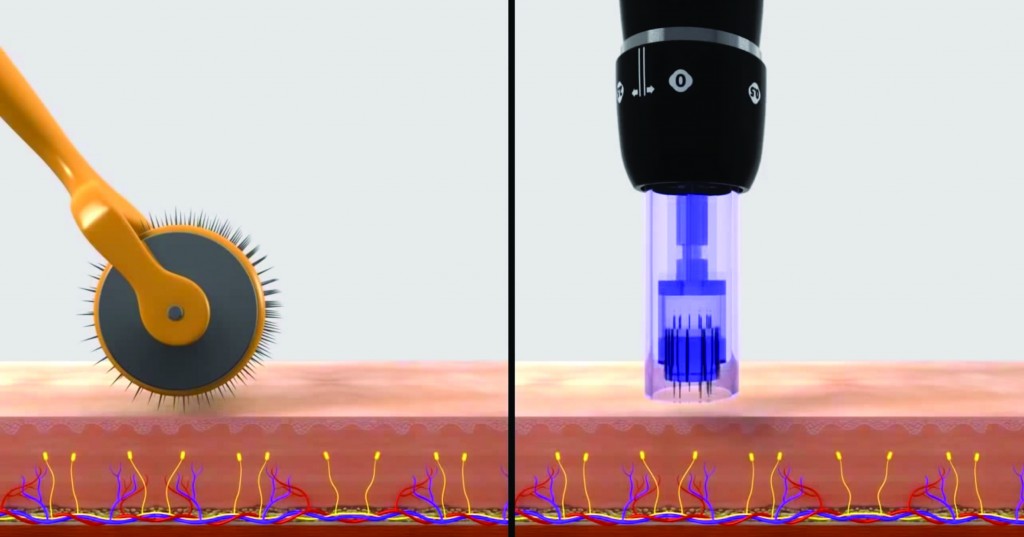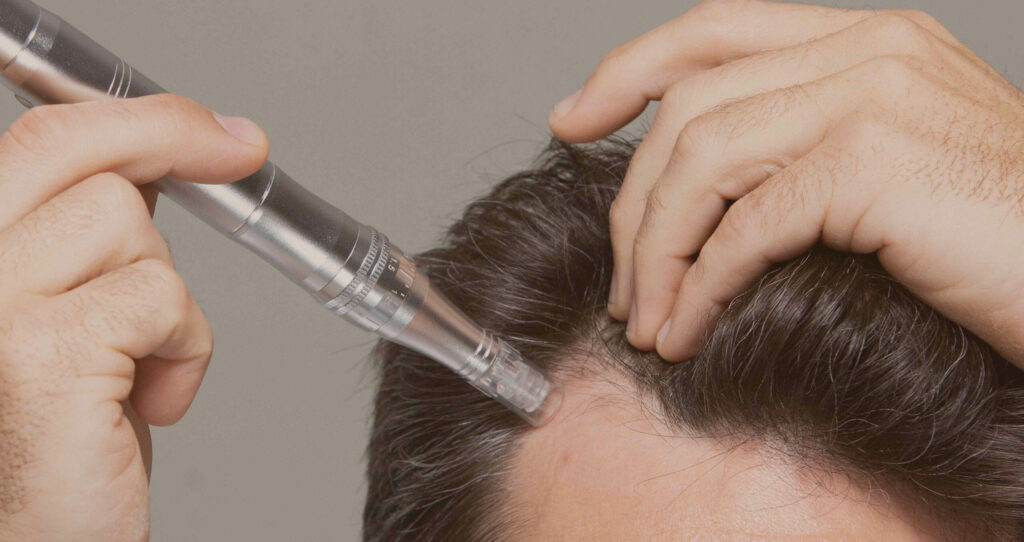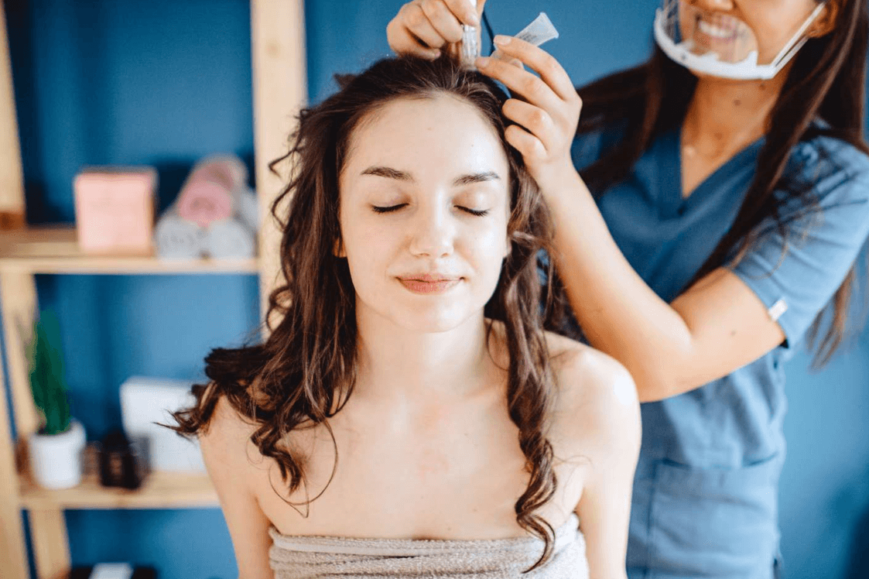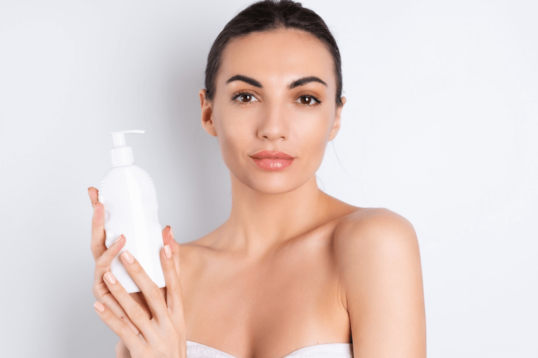One million people worldwide are affected by hair loss. It is not merely skin deep; confidence and self-esteem are eroding. You know how it feels to struggle with bald spots or thinning hair.
Introducing micro-needling, a revolutionary treatment that shatters the cycle of hair loss and despair.
One of the most promising treatment approaches for hair loss could be micro-needling. With a clean roller equipped with tiny needles, this procedure is not invasive and involves making controlled micro-injuries on the scalp.
These micro-channels help promote collagen and blood flow to the region, thus triggering the body’s natural healing process. This improved blood circulation and cell proliferation may effectively stimulate hair follicle growth and prevent hair thinning.
PRP (Platelet-Rich Plasma) therapy and micro-needling can be combined for better outcomes. Rich in growth factors, platelet-rich plasma (PRP) is a concentrated solution of your own platelets that can hasten hair growth and healing. In a combination treatment, PRP is administered topically to the scalp after micro-needling has created micro-channels. This allows the growth factors to enter the scalp more deeply and nourish the hair follicles.
We’ll discuss the advantages of micro-needling and why it might be the best option for you. Say goodbye to anxieties about hair loss and uncover a route to healthier, more abundant Hair. Now, let’s get started!
What is Micro-needling?
The Procedure of Micro-needling

Step-by-Step Guide: What to Expect Embarking on a micro-needling session is like setting sail on a voyage towards hair revival. Here’s what to anticipate:
One therapeutic method for addressing hair loss is microneedling. It can enhance hair thickness and growth by promoting the scalp’s natural healing process.
First Evaluation: A specialist will evaluate your hair loss situation and decide whether microneedling is right.
Tailored Plan: Based on the evaluation, the specialist will create a personalized treatment plan, considering the needle size, the frequency of treatments, and any additional therapies.
Scalp Cleaning: The specialist will cleanse your scalp using an antiseptic solution to avoid infection.
Topical Anesthesia: To reduce discomfort during the surgery, a numbing lotion may be used.
Device Selection: Based on your scalp condition, the specialist chooses a professional-grade micro-needling pen or derma roller with the correct needle length.
The experience boosts hair follicles and promotes the creation of new hair by using the device to produce tiny incisions in the scalp.
Pattern: To guarantee even treatment area coverage, they will adhere to a predetermined pattern.
Because the microchannels allow for greater penetration, the expert may add topical medicines such as PRP or minoxidil after microneedling to strengthen hair growth.
Instructions for Aftercare: The specialist offers comprehensive post-treatment recommendations to guarantee appropriate healing and optimize the therapeutic effects.
Frequent Sessions: To track improvement and provide further treatments as necessary, the specialist arranges follow-up appointments every two to four weeks.
Progress Monitoring: They will watch how well the therapy works using pictures and scalp exams.
The specialist provides advice on long-term scalp care to keep hair healthy over the long run.
An expert ensures that micro-needling for hair loss is completed safely and with attention to detail at every step. A structured approach can help achieve the best hair regrowth and scalp health outcomes.
While micro-needling can benefit certain types of hair loss, it’s essential to have realistic expectations and understand that results may vary. Always consult with a healthcare professional before beginning any new treatment.
During the microneedling procedure, use serums rich in nutrients that comprise peptides, vitamins, and biotin. By creating micro-channels through microneedling, these nutrients can be absorbed more effectively straight into the scalp.
Efficacy and Research: Micro-needling’s Impact on Hair Loss
Micro-needling has been the subject of various studies, and the results highlight its potential in treating hair loss conditions like androgenic alopecia and alopecia areata. Here are the key points, presented in bullet form for clarity:
- Androgenic Alopecia (AGA)
- Studies show micro-needling can improve hair count and thickness when used with topical treatments like minoxidil.
- The procedure enhances the absorption of topical agents, leading to better treatment outcomes.
- Regular sessions have been associated with increased hair growth in individuals with AGA.
- Alopecia Areata (AA)
- Research indicates micro-needling alone can stimulate hair regrowth in AA cases.
- It may be as effective as other treatments like corticosteroid injections or topical immunotherapy.
- The treatment’s efficacy is attributed to its ability to induce a natural healing response.
- General Findings
- Micro-needling is generally well-tolerated with minimal side effects.
- It can be used in conjunction with other hair loss therapies for better outcomes.
- The process is adaptable and can be customized to meet specific requirements and conditions related to hair loss.
These points underscore the therapeutic promise of micro-needling for those experiencing hair loss, offering a beacon of hope for effective management and treatment.
Avoid sun exposure and using harsh products on your scalp in the days leading up to your treatment.
The Benefits of Micro-needling for Hair Loss

Micro-needling has emerged as a beacon of hope for those grappling with hair loss, offering many benefits beyond the surface. Here’s how this innovative technique is making waves in the realm of hair regeneration:
Micro-needling offers a promising path for hair loss treatment, with the added benefit of enhancing the performance of topical agents like minoxidil. It’s a testament to the power of combining traditional methods with modern technology to achieve optimal hair care and restoration results.
For hair to stay healthy, a diet high in vitamins and minerals is necessary. Vitamins A, C, D, E, zinc, iron, and omega-3 fatty acids are among the nutrients that are essential for healthy hair development and strength.
Who is a Good Candidate for Micro-needling?
Micro-needling is suitable for individuals experiencing hair thinning or hair loss who are seeking a minimally invasive treatment option. Ideal candidates typically include:
Ideal Candidates
- Men and Women: Microneedling benefits all sexes experiencing hair thinning or the beginning stages of hair loss.
- Age Range: 18 to 65 years old, while older applicants might also benefit based on their particular situation.
- General Good Health: Individuals without severe underlying health issues that may hinder healing.
Conditions Suitable for Micro-needling
Micro-needling can effectively address various hair loss conditions, including:
- Androgenic alopecia: Also understood as male or female pattern baldness, this condition causes progressive hair thinning and loss.
- Alopecia Areata: This autoimmune disorder causes patchy hair loss on the scalp and other body regions.
- Telogen Effluvium: A transient hair loss frequently brought on by illness, stress, or hormonal fluctuations.
- Hair Thinning in General: Not Particular Age, hormone abnormalities, and environmental conditions can all cause hair thinning.
When to Consult a Doctor for Suitability
To ascertain whether microneedling is the appropriate treatment for hair loss, speaking with a dermatologist or healthcare professional is imperative. Consultation should be sought if:
- Persistent Hair Loss: Despite attempting alternative therapies, you continue to observe bald spots or thinning Hair.
- Medical History: You’ve previously had autoimmune diseases, skin issues, or drug interactions that can impair healing.
- Uncertain About Causes: If you are still unsure about the underlying cause of your hair loss, you require a professional diagnosis.
- Investigating your alternatives for therapy: You want to know about all of your treatment options and how microneedling fits into the larger picture of hair restoration.
A consultation will typically involve:
- A thorough assessment of your scalp.
- A review of your medical history.
- A discussion about your hair restoration goals.
This ensures that micro-needling is tailored to your needs and provides the best possible outcomes.
Micro-needling vs. Other Hair Restoration Methods
Certainly! Here’s a comparison of micro-needling with PRP therapy and Laser Hair Therapy, including the pros and cons of each method and insights on combining treatments for optimal results:
| Treatment | Micro-needling | PRP therapy | Laser Hair Therapy |
|---|---|---|---|
| How it work | Fine needles create micro-injuries stimulating healing and hair growth. | It involves infiltrating platelet-rich plasma into the scalp to promote hair growth. | Utilizes light energy to stimulate hair follicles and encourage growth. |
| Pros | It is minimally invasive, stimulates natural healing, and can be combined with other treatments. | It uses the body’s own growth factors, can target specific areas, and has minimal side effects. | It is also non-invasive, can treat large areas, and has relatively quick sessions. |
| Cons | It may cause provisional redness or swelling; multiple sessions are needed. | It requires a blood draw, effectiveness may vary, and there is a higher cost per session. | It may not be suitable for all hair types, with the potential for temporary hair loss. |
| Combining Treatments | PRP is often combined with micro-needling or laser therapy for enhanced results. | It can be used with micro-needling or laser therapy for a synergistic effect. | It can be paired with micro-needling or PRP to address hair loss comprehensively. |
Combining these procedures can provide a thorough approach to hair restoration for optimal results by addressing various facets of hair loss and utilizing the advantages of each technique. Always seek the advice of a healthcare provider to customize the ideal treatment plan for your circumstances. Combiningects and Considerations
Common Side Effects of Micro-needling on the Scalp
Important Considerations and Contraindications
Cost of Micro-needling for Hair Loss
Cost Comparison Table
| Micro-needling | Average cost of Microneedling |
| INR | RS 1500 to RS 5000 per session |
| USD | $200 to $ 700 per session |
Factors Influencing the Cost
- Clinic Location and Reputation: Urban clinics and well-established medical centres often charge higher fees due to their reputation and the quality of service.
- Practitioner’s Experience: Highly experienced and specialized practitioners may charge more for their expertise.
- Number of Sessions: The overall cost will vary based on the number of sessions recommended for optimal results.
- Additional Treatments or Services: Combining PRP micro-needling with other treatments, such as laser therapy or additional hair care services, can increase the overall cost.
- Insurance Coverage and Financing Options: PRP micro-needling for hair loss is generally considered a cosmetic procedure and is not covered by insurance. However, some facilities do provide payment plans or financing alternatives to make the therapy more accessible.
By considering these factors, patients can better understand the investment required for PRP micro-needling and plan accordingly for their hair restoration journey.
Pros and Cons of Micro-needling
Pros
- Cost-Effective: Lower cost compared to professional treatments.
- Convenience: can be done at home at your convenience.
- Control: You control the process, including timing and frequency.
Cons
- Risk of Infection: Higher risk if proper hygiene isn’t maintained.
- Lack of Expertise: Potential for improper technique leading to ineffective results or damage.
- Quality of Tools: At-home devices may be less effective than professional equipment.
Doing it Yourself: Micro-needling for Hair Loss.

Steps for At-Home Micro-needling
Use a derma roller or pen specifically designed for hair loss treatment.
Ensure the needle length is appropriate (0.25mm to 0.5mm is generally recommended for scalp use).
Clean the scalp thoroughly with a mild shampoo to remove dirt or oils.
Disinfect the micro-needling device with isopropyl alcohol.
Apply a numbing cream if you are sensitive to pain. Follow the instructions for application and removal.
Section your Hair to access the scalp more easily.
To guarantee even coverage, gently roll or glide the device over the scalp in the horizontal, vertical, and diagonal directions.
Apply light pressure; do not press too hard to avoid damaging the scalp.
Clean the scalp again with a gentle shampoo.
Apply a topical hair growth serum (minoxidil) to the treated area to enhance absorption.
Avoid using harsh hair products or exposing the scalp to direct sunlight for a few days.
Safety Tips
When to Seek Professional Help
Conclusion
Micro-needling for hair loss offers a promising, minimally invasive solution that stimulates natural hair growth, enhances the absorption of topical treatments, and can be combined with other therapies like PRP for optimal results. The procedure leverages the body’s natural healing process to rejuvenate hair follicles, improving hair density and thickness over time.
Despite its advantages, microneedling must be done under the supervision of a trained professional to guarantee safety and optimize results. Speaking with an expert can ensure that the treatment is customized to your unique requirements and that your progress is regularly tracked.
(FAQs) about Micro-needling for Hair Loss
How does micro-needling promote hair growth?
Microneedling improves blood flow and boosts the scalp’s collagen and elastin synthesis, which feeds hair follicles and promotes hair growth. Additionally, it makes tiny holes in the scalp that improve the absorption of nutrients and topical medications.
How many sessions are required before results are apparent?
The number of sessions required is determined on the individual’s current status and the desired goals. A series of three to six treatments spread out over several weeks is usually recommended for optimal results.
Is there any downtime after micro-needling?
Minimal downtime is required for hair loss microneedling. Following the surgery, patients may suffer brief redness, swelling, or slight discomfort; however, these side effects usually go away in a day or two.
Can micro-needling be combined with other hair loss treatments?
Other hair restoration procedures including PRP therapy, laser therapy, and topical hair growth therapies can be used in conjunction with microneedling. Combining therapies can frequently improve outcomes and encourage hair regrowth that is more noticeable.
How long does a microneedling session last?
Depending on how many locations need to be treated, a treatment session only lasts 20 to 30 minutes. But you have to wait for your treatment area to be cleansed and for the numbing cream to start working. You should budget at least one or two hours to complete the task.
Is micro-needling painful?
Even though a topical numbing lotion is usually administered to the scalp before to the operation, some people may suffer slight discomfort during microneedling. The majority of patients report good tolerability of the medication.

